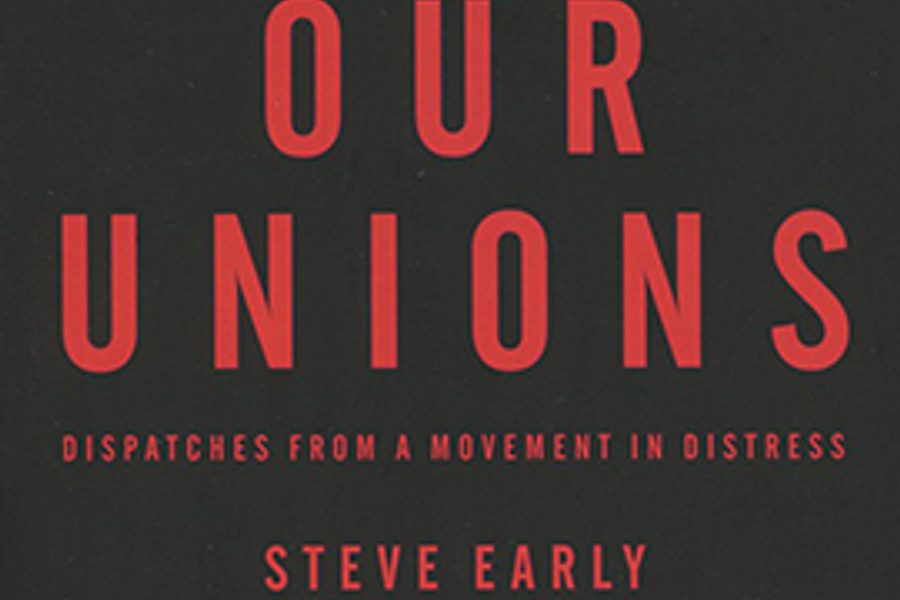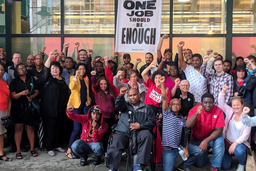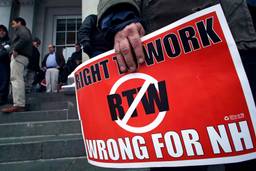
The defeat of a union organizing election at the Volkswagen auto plant in Chattanooga, Tenn. this month has stimulated intense national scrutiny of the United Auto Workers (UAW). As labor’s friends and enemies debate over the places UAW leadership fell short in the campaign, journalist Steve Early’s new book, Save Our Unions: Dispatches From a Movement in Distress (Monthly Review Press) seems especially relevant. Though Early’s work doesn’t analyze the Volkswagen campaign itself — and makes only passing references to the UAW — the declining power of the country’s leading labor organizations is a consistent theme in his reporting.
The book is first and foremost a journalistic enterprise, bringing together news articles and related material that Early produced for a long list of labor-friendly publications, including In These Times. Labor reporting is a second career for Early, who spent 27 years as a Boston-based staffer for the Communications Workers of America (CWA), and he brings to his work a real depth of understanding about how unions work in practice. This is his third book since retiring from CWA in 2007—Embedded with Organized Labor: Journalistic Reflections on the Class War at Home was published in 2009, followed by The Civil Wars in U.S. Labor in 2011 — and the three volumes together present a well-researched and crisp account of Big Labor’s troubles in the modern era.
Early is especially well known for his reporting in recent years on the Service Employees International Union (SEIU), particularly the efforts by some of the union’s California branches to break away and establish the National Union of Healthcare Workers (NUHW). And Save Our Unions contains plenty of material on NUHW’s post-schism campaigns to recruit new members out of SEIU’s ranks, as well as the continuing SEIU-NUHW clashes that have ensued. Early’s sympathy with NUHW is plainly stated and supported by a stinging critique of SEIU’s leadership. He depicts senior SEIU officials as divorced from the workplace concerns of most members, overly accommodating to the financial goals of large employers, and ham-handed in their dealings with union rank and file. Ultimately, his narrative is that of the NUHW as a scrappy underdog struggling against an entrenched and largely unresponsive SEIU bureaucracy.
That antiestablishment theme is echoed in Early’s reporting on other labor organizations in Save Our Unions, including his coverage of the International Brotherhood of Teamsters’ 2011 presidential election. The race in question was a three-way contest between incumbent president James P. Hoffa and two other union officers — pension administrator Fred Gregare and New York City local leader Sandy Pope. As the candidate from the dissident group Teamsters for a Democratic Union, Pope campaigned for stronger union contracts and against the high salaries and generous perks granted to union leaders. But her on-the-ground activism didn’t resonate widely with union voters. When the ballots were counted, Hoffa had racked up an impressive victory, trouncing both Gregare and Pope. Early doesn’t dwell too long on the apparent contradiction between his faith in rank-and-file democracy and the plainly expressed preference of Teamster voters. Instead, he counts the election as another instance of union officers manipulating the system to cling to power at a time that demands fresh and inventive approaches.
In an interview with In These Times, Early insists that his journalism is not intended to hammer the existing power structure of Big Labor, but rather to celebrate innovations in union organizing, especially at the grassroots level. But the conflicts he portrays are almost always centered on union leaders stubbornly resisting any change that might chip away at their power and privilege.
He savages American Federation of State, County and Municipal Employees (AFSCME) leader Gerald McEntee, for example, for holding the union in an iron grip for 30 years before delivering the presidency to his hand-picked successor Lee Saunders in 2012. Early also implicitly blames McEntee and other high-ranking officials for the 2011 fiasco in Wisconsin, when anti-union legislation sponsored by Gov. Scott Walker proved especially destructive to AFSCME.
AFL-CIO President Richard Trumka, now aged 64, is not spared either. Early wonders — rather wearily — if Trumka will follow the example of his federation predecessors and remain in office into his 80s; such scrutiny seems especially apt considering other critics’ observations of Trumka’s overall failure to stem labor’s decline during his presidency. An acceptance of term limits, or a mandatory retirement age, is long overdue at the highest levels of the Big Labor hierarchy, Early argues. Not only would that allow younger, fresher blood to rise, he writes, but many of labor’s senior leaders could serve workers’ interests far better in other fields, like academia or electoral politics.
Early is an avid consumer of other labor-related books and news articles; Save Our Unions finds him frequently engaging with these sources on an in-depth level. One highlight is his treatment of Raising Expectations (and Raising Hell), a 2012 memoir by Jane McAlevey detailing her years as a mid-level SEIU officer. Early delights in skewering the SEIU, of course — especially retired leader Andy Stern — and he takes McAlevey to task, too, for being what he calls a “progressive prima donna” who benefited from the very structures she lambasts. On a more academic note, Early is meticulous when it comes to references: The book contains extensive endnotes for readers who want to seek out additional details of the multiple labor dramas presented.
By his own account, Early does not intend to offer any grand scheme for rescuing labor from its current troubles, so any student of last week’s defeat in Chattanooga will not find any direct answer to UAW’s problem in these pages. (He did, however, publish his own “postmortem” in CounterPunch on February 19; unsurprisingly, he found fault with the UAW leadership.) Early does seem to imply that his home union is a good example for others to follow — for the most part, his fascinating descriptions of CWA’s long-running organizing campaigns at T-Mobile and the 2011 Verizon strike remain free from critique, and the book is dedicated to CWA President Larry Cohen, described “as the best of his generation in labor.”
Overall, Early’s workmanlike journalism is at its best when he illuminates the day-to-day problems faced by labor, such as the apparently intractable problems unions encounter with Obamacare. By leaving the grander themes and prescriptions for salvation to others, he can focus on his clear passion: the struggles of the rank-and-file against the powerful force arrayed against it, including, too often, its own leaders.
Full disclosure: The UAW, CWA and AFSCME are website sponsors of In These Times. Sponsors have no role in editorial content.

I hope you found this article important. Before you leave, I want to ask you to consider supporting our work with a donation. In These Times needs readers like you to help sustain our mission. We don’t depend on—or want—corporate advertising or deep-pocketed billionaires to fund our journalism. We’re supported by you, the reader, so we can focus on covering the issues that matter most to the progressive movement without fear or compromise.
Our work isn’t hidden behind a paywall because of people like you who support our journalism. We want to keep it that way. If you value the work we do and the movements we cover, please consider donating to In These Times.






